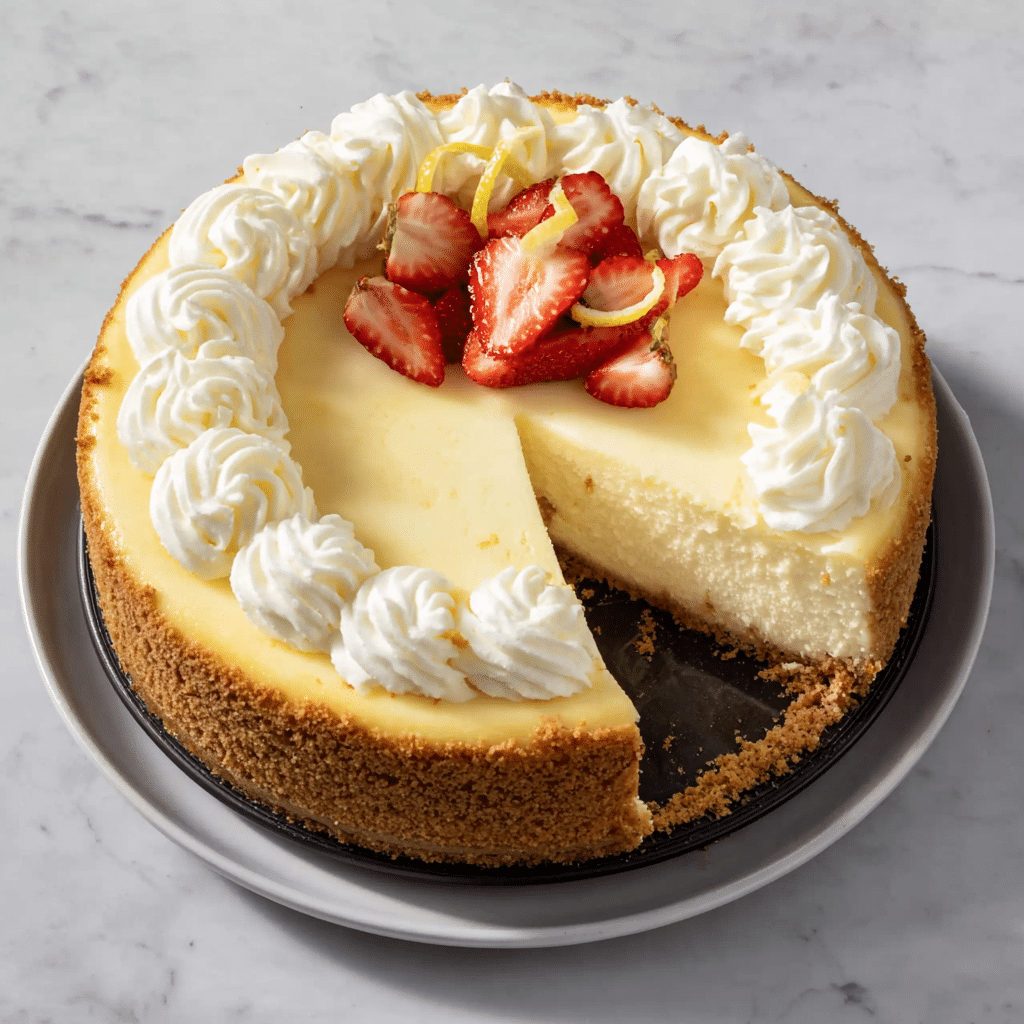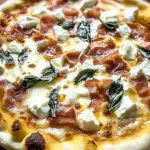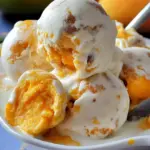Few desserts embody simplicity and sophistication quite like a New York-style cheesecake. With its dense, creamy filling and crisp graham cracker base, it’s a dessert that always makes an impression—whether served at a dinner party or enjoyed quietly with coffee on a Sunday afternoon. The smooth texture paired with the slight tang from sour cream and lemon juice makes each bite wonderfully balanced, while the crust adds a perfect contrast in both flavor and crunch.
What’s beautiful about this cheesecake is its adaptability. Serve it plain for a minimalist delight, or top it with fresh berries, fruit compote, or a drizzle of chocolate or caramel to suit the occasion. This baked cheesecake offers consistency in texture and flavor that no no-bake version can quite replicate, and its velvety interior paired with a golden edge makes it a staple recipe every baker should master.
Full Recipe
Ingredients:
-
2 cups graham cracker crumbs
-
½ cup unsalted butter, melted
-
3 (8 oz) packages cream cheese, room temperature
-
1 cup granulated sugar
-
1 cup sour cream, room temperature
-
3 large eggs
-
1 tbsp vanilla extract
-
1 tbsp lemon juice
-
Pinch of salt
Directions:
-
Preheat your oven to 325°F (160°C). Line the bottom of a springform pan with parchment paper.
-
In a bowl, mix the graham cracker crumbs and melted butter until evenly moistened. Press firmly into the bottom of the pan.
-
In a large mixing bowl, beat cream cheese and sugar until smooth and creamy, about 2-3 minutes.
-
Add sour cream, vanilla extract, lemon juice, and salt. Mix until fully incorporated.
-
Add eggs one at a time, mixing on low speed after each just until combined. Do not overmix.
-
Pour the batter over the crust and smooth the top.
-
Place the springform pan in a larger pan and fill the outer pan with hot water halfway up the sides of the cheesecake pan.
-
Bake for 55–70 minutes or until the edges are set but the center is slightly jiggly.
-
Turn off the oven and let the cheesecake sit inside with the door cracked for 1 hour.
-
Remove from the oven, cool to room temperature, then chill in the fridge for at least 4 hours or overnight.
Prep Time: 25 minutes | Cooking Time: 1 hour 10 minutes | Total Time: 6 hours including chilling
Kcal: 450 kcal | Servings: 12 servings
Classic Baked Cheesecake: A Timeless Dessert Masterpiece
Cheesecake is one of the most universally loved desserts, and the classic baked version is the crown jewel of them all. This dessert has roots in ancient Greece but has evolved significantly over the centuries to become the creamy, indulgent slice of heaven we know today. The version commonly recognized and celebrated today is the New York-style baked cheesecake, which sets itself apart with its rich, dense texture and subtle tang that perfectly balances the sweetness. Whether served at a formal dinner party or as a weekend treat, baked cheesecake never fails to impress.
The Elegance of Simplicity
The beauty of a classic baked cheesecake lies in its simplicity. With only a few staple ingredients—cream cheese, sugar, eggs, sour cream, and a buttery graham cracker crust—this dessert transforms humble elements into a luxurious experience. Unlike its no-bake counterparts, baked cheesecake relies on slow oven heat and patient chilling to develop its signature texture: dense yet creamy, firm yet melt-in-your-mouth. This contrast is what makes it such a beloved choice across generations and cultures.
The Texture That Sets It Apart
What truly distinguishes a baked cheesecake is its texture. Baking the cheesecake in a water bath at a gentle temperature ensures a smooth, crack-free top and uniform doneness throughout. The slow cooking method creates a rich, velvety texture that’s impossible to achieve with refrigeration alone. Additionally, the sour cream adds a slight tartness, enhancing the depth of flavor and making each bite both indulgent and refreshing.
The Crust: A Buttery Foundation
No cheesecake is complete without a solid foundation, and in this case, it’s the graham cracker crust. It’s the perfect companion to the creamy filling, adding a crunchy, buttery contrast that holds everything together. Made with crushed graham crackers and melted butter, the crust is pressed into the base of a springform pan, baked briefly, and then topped with the luscious filling. Some bakers prefer to flavor the crust with a pinch of cinnamon or a touch of sugar, which elevates the flavor profile even more.
Flavor Variations and Customizations
One of the greatest joys of baking a classic cheesecake is how easy it is to customize. Though the base recipe is delicious on its own, it serves as a blank canvas for a wide range of flavor combinations. From fruit toppings like strawberries, raspberries, or blueberries to chocolate ganache, caramel drizzle, or even a nut brittle layer, there are endless possibilities. You can also infuse the batter with lemon zest, vanilla bean, or spices like cinnamon or cardamom to add complexity without altering its essence.
Presentation Matters
A well-presented cheesecake can steal the spotlight on any dessert table. Its tall, clean sides and creamy surface make it an ideal base for decorating. Many bakers opt to top their cheesecake with fresh fruit, edible flowers, powdered sugar, or elegant sauces. A slice of cheesecake with glossy berry compote and a sprig of mint is visually stunning and mouthwatering. For formal events, you can slice the cheesecake into even wedges and serve it on dessert plates with forks carefully placed, often with a drizzle of sauce and a few garnishes for flair.
Baking Tips for Success
Baking the perfect cheesecake can be intimidating, but with a few key tips, anyone can master it. First and foremost, all ingredients should be at room temperature to ensure smooth blending. Overmixing should be avoided as it can incorporate too much air and cause cracking during baking. A water bath, or bain-marie, is essential to gently cook the cheesecake and maintain its moisture. Finally, cooling the cheesecake gradually is crucial—letting it sit in the oven after baking, then cooling on the counter before chilling in the fridge helps prevent temperature shock and cracking.
Why This Cheesecake Stands Out
This particular baked cheesecake recipe captures everything that makes this dessert extraordinary. It strikes a perfect balance between creamy and firm, tangy and sweet. The graham cracker crust is golden and buttery, the filling is luscious and rich, and the top is beautifully smooth and unblemished. Unlike store-bought cheesecakes, which may use stabilizers or shortcuts, this homemade version relies purely on technique and quality ingredients, which results in a superior taste and texture.
Perfect for Every Occasion
Whether you’re celebrating a birthday, hosting a dinner party, or simply treating yourself on a quiet weekend, this baked cheesecake is a go-to dessert. It’s universally appealing, easy to dress up or down, and has a comforting familiarity that never gets old. You can prepare it a day in advance, which makes it a perfect make-ahead dessert. Its ability to impress with minimal effort makes it a kitchen staple for both novice and experienced bakers alike.
Pairing Suggestions
Baked cheesecake is incredibly versatile when it comes to pairing. On its own, it pairs beautifully with coffee or tea. Add a splash of fruit syrup or a glass of dessert wine, like a late-harvest Riesling or Moscato, and it becomes a gourmet experience. For a seasonal twist, top with spiced apples in the fall or fresh berries in the spring. Pairing it with a tangy compote can also cut through the richness and balance the palate perfectly.
Storage and Shelf Life
Properly stored in the refrigerator, baked cheesecake can last up to 5–7 days. It should be covered tightly with plastic wrap or kept in an airtight container to prevent it from absorbing fridge odors. Cheesecake also freezes beautifully. Slice it into portions, wrap each slice in parchment and plastic wrap, then store in a freezer-safe container. This makes it easy to enjoy a piece of cheesecake anytime, without having to bake a whole one from scratch.
Nutritional Perspective
While cheesecake is undoubtedly indulgent, enjoying it in moderation is part of a balanced lifestyle. The protein and fat from the cream cheese and eggs make it a more satisfying dessert compared to empty-calorie sweets. If you’re watching your sugar intake, you can easily reduce the sugar content or substitute with alternatives like coconut sugar or erythritol. Additionally, gluten-free versions can be made using almond flour or gluten-free graham crackers for the crust, making it accessible for those with dietary restrictions.
Conclusion
Classic baked cheesecake is more than just a dessert—it’s a culinary tradition that has stood the test of time. Its rich, creamy filling and buttery crust come together to form a dessert that is both elegant and comforting. It’s a recipe that can be passed down through generations, tweaked and perfected, but always loved. Whether you’re baking it for the first time or the hundredth, the result is always rewarding. This baked cheesecake is not just a treat; it’s a celebration of timeless flavor, simple ingredients, and the joy of homemade baking. It’s a must-have in every dessert lover’s repertoire and a guaranteed crowd-pleaser for any occasion.






